Home » Hunting Dogs » Wirehaired Pointing Griffon – Dog Breed Information, Form, Function, History, and More
Wirehaired Pointing Griffon – Dog Breed Information, Form, Function, History, and More
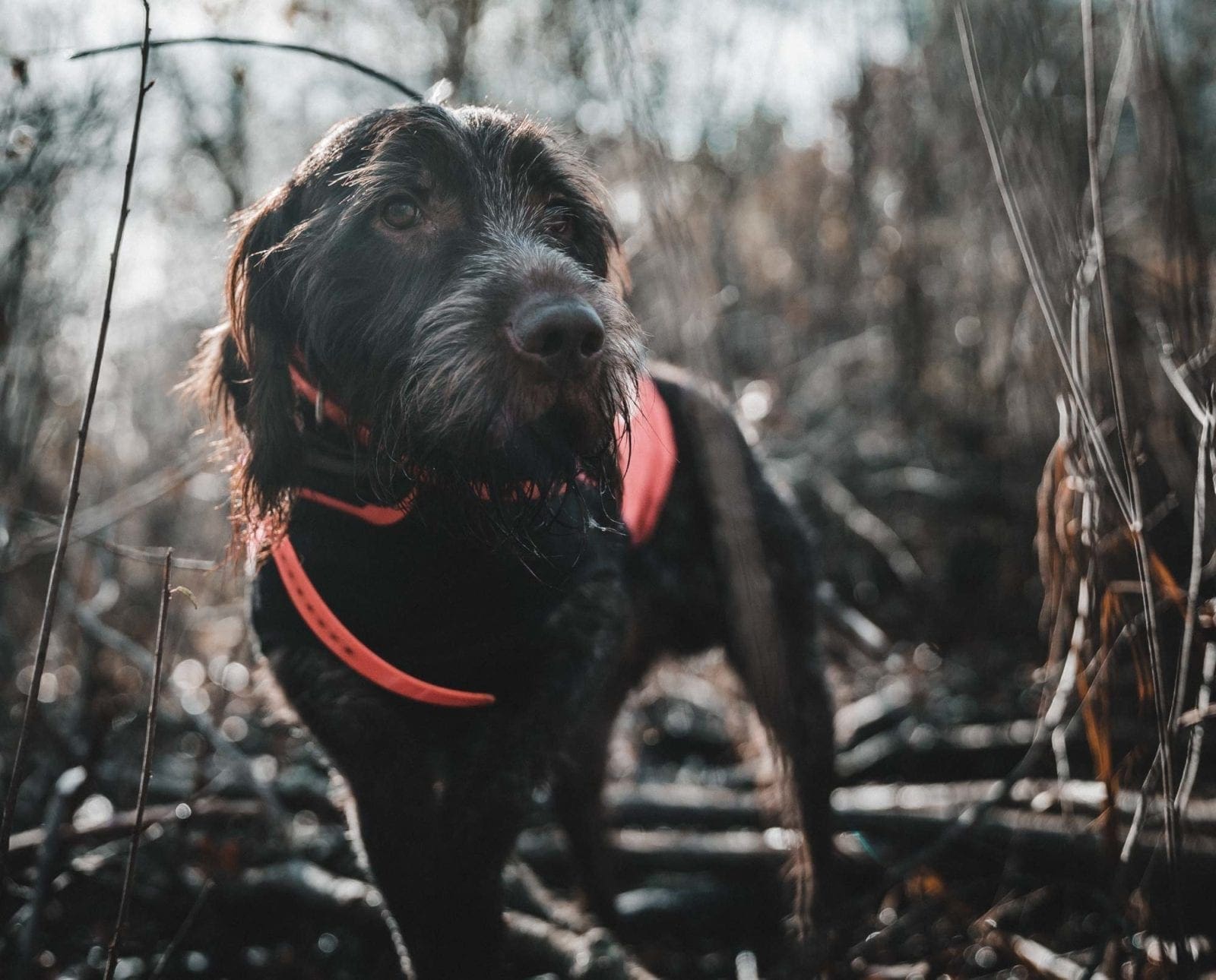
From their home base in Winnipeg, Craig Koshyk and Lisa…
The Wirehaired Pointing Griffon is a medium-sized dog that combines a rough-and-tumble coat with a driven but friendly personality
The word griffon (or griffin) can be traced back to the Greek and Latin roots meaning “hook” or “claw” or even “hawk” ( i.e., a bird with claws). Long ago, it was the name of a mythical beast with the head of an eagle and the body of a lion—with clawed feet, of course.
Listen to more articles on Apple | Google | Spotify | Audible
Eventually the word “griffon” became associated with many of the rough-coated dog breeds found throughout Europe. That is why the word “pointing” is in the name of the Korthals griffon. It is there to indicate that, unlike the Blue Gascony griffon, a type of running hound, or the Belgian griffon, a companion breed, the wirehaired pointing griffon is a pointing breed. The name also refers to the wire-haired coat. This is to differentiate it from other griffons with non-wiry coats, such as the French woolly-haired pointing griffon developed by Emmanuel Boulet and the Brabançon griffon that has a smooth coat.
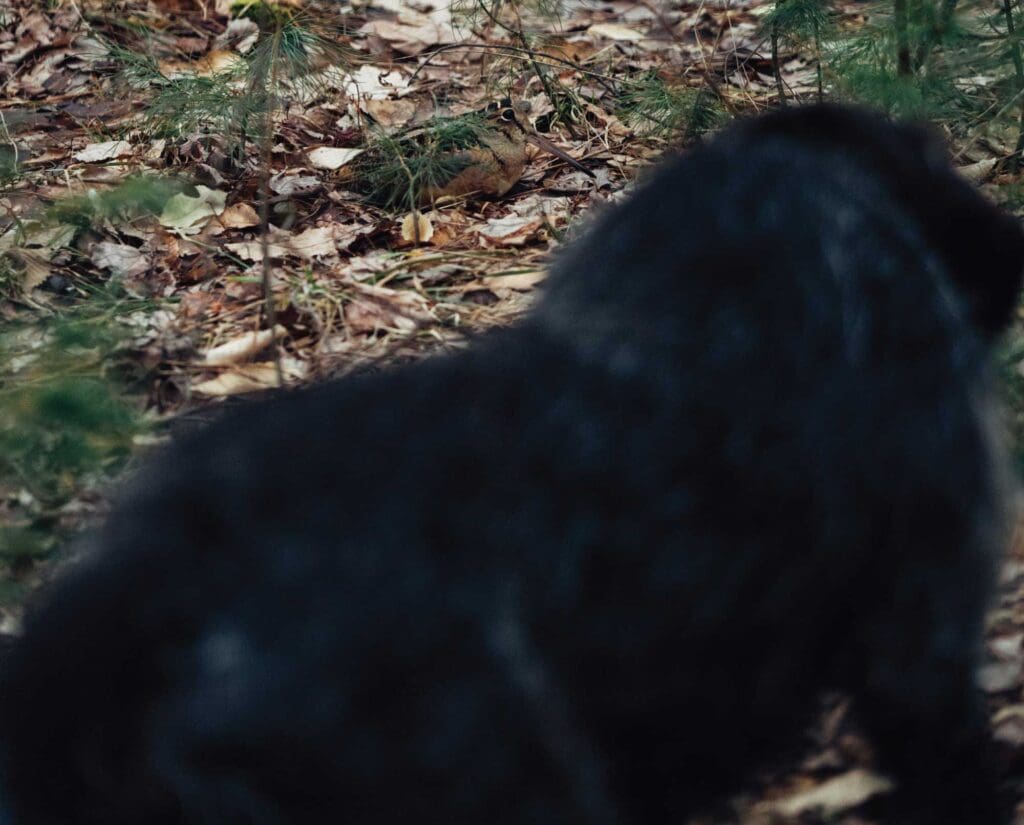
Wirehaired Pointing Griffon Form
Wirehaired Pointing Griffons can sometimes be mistaken for other wire-haired breeds such as the German Wirehaired Pointer, Cesky Fousek or Stichelhaar. On average, however, Wirehaired pointing griffons are slightly smaller than those breeds and tend to have a longer coat and more pronounced beard, moustache and eyebrows.
Size of the Wirehaired Pointing Griffon
Males: 23-26 inches (58-63 cm) and 55-69 pounds
Females: 21.5-24 inches (55-60 cm) and 50-65 pounds
Coat of the Wirehaired Pointing Griffon
In terms of length and harshness, the Wirehaired Pointing Griffon’s coat may be the most variable of all the wire-haired breeds. I have seen Griffons with practically short-haired coats and Griffons with very long, woolly coats, and nearly everything in between.
According to the breed’s FCI standard, the ideal coat is harsh and coarse, reminding of the touch of a wild boar’s bristles. The AKC standard does not mention boars’ bristles probably because most Americans have never seen a wild boar, let alone touched its bristles. Nevertheless, the coat is made up of a coarse, harsh topcoat and a fine, dense undercoat. Wirehaired Pointing Griffons should have pronounced eyebrows and a full beard and moustache.
The coat color is generally a steel-grey shade with liver patches. It is often seen in a liver roan pattern with a mixture of brown and white hairs. Wirehaired Pointing Griffons can also be “self-colored”, that is to say, all brown. The FCI standard also states that clear white and brown coats and white and orange coats are permissible, but such coats are extremely rare. The AKC standard states that a uniformly brown coat, all-white coat, or white and orange are less desirable. Neither standard allows black.
Historically, there were other coat colors associated with Griffons. Jean Castaing himself had an almost all-white Griffon and Pierre Mégnin, in his book Les Races de Chiens (1889), describes dogs that had mainly white coats with brown and tan ticking.
Character of the Wirehaired Pointing Griffon
When describing the Wirehaired Pointing Griffon’s personality, owners and breeders often use terms such as outgoing, fun loving and eager to please.
According to Serge Dumont, a Wirehaired Pointing Griffon breeder in Quebec with over 30 years’ experience with the breed:
“The typical Griffon is a great family dog, good with kids and easy to get along with. They tend to be on the calm side, but they are still hunting dogs with a lot of energy–not couch potatoes.”
Wirehaired Pointing Griffon and Protection
A hallmark of the breed is sweet, friendly personality. However the FCI breed standard actually refers to a natural protective instinct, stating that Korthals Griffon is attached to his master and his territory, which he guards with vigilance. The German Griffon club seems to agree, stating on their website that the breed is regarded as a good family dog with pronounced protection drive.
Training Wirehaired Pointing Griffons
The Griffon is best trained by using a soft touch. Harvey Storey, a Griffon owner in Oregon, sums it up well:
“You really have to go softly and let the dog think that it had thought of everything. Give the dog the opportunity and it’ll figure things out. Force the issue, and you may create a roadblock.”
Serge Dumont agrees:
“Time and patience are the best tools, better than using force. You should be in control of your own emotions when you train. After all, you have just as much to learn about your dog as it does about you.”
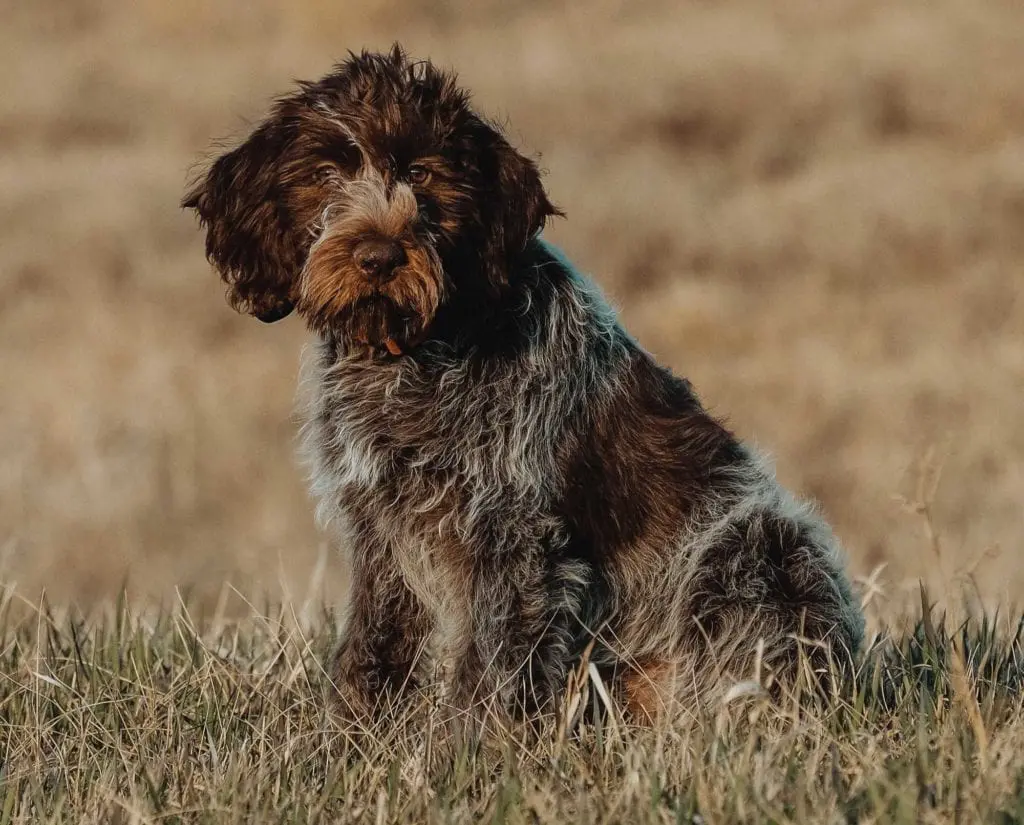
Wirehaired Pointing Griffon Populations
The Wirehaired Pointing Griffon is becoming increasingly popular in the United States. NAVHDA registration has shown over a 63% increase in numbers over the past 10 years and is the second most registered breed. Approximate numbers in France would out the Wirehaired Pointing Griffon at 10,000 to 15,000. Another 3000 to 4000 in Canada, the UK, Germany, the Netherlands and Belgium combined.
Wirehaired Pointing Griffon Health Issues
The Wirehaired Pointing Griffon faces all the same health-related challenges as the other Continental breeds. In addition, there have been reports of panosteitis, and inflammatory condition of the long bones. They have also been isolated reports of entropion, a condition with their eyelids that may require corrective surgery.
Function of the Wirehaired Pointing Griffon
The Wirehaired Pointing Griffon is prized for its all-around abilities and admired for its feline style movement, excellent nose and ability to work in the toughest conditions.
Wirehaired Pointing Griffon Field Search Abilities
While there is some variation within the breed, on average Griffons hunt at a smooth, sustained gallop out to medium range. Some dogs from field trial lines in France run much faster and wider than average. Yet for some reason the idea that Wirehaired Pointing Griffons are slow and very close-working dogs has taken hold in certain circles, particularly in North America. It is not uncommon to see words like “careful”, “methodical” or even “plodding” used to describe a Griffon’s field search. One American author even wrote that the Griffon “is very definitely the closest-working and about the slowest, most deliberate pointing breed available in North America.”
That description is a far cry from how Wirehaired Pointing Griffons were first described in the press after a field trial held in 1897. Reporters on the scene described them as hunting at such a fast gallop and distance that they “astonished” the men of the time. Other reports from the same period describe dogs handled by well-known personalities, including Korthals himself, searching as far as the horizon and running almost as fast as English Pointers and English Setters. There are even reports of Wirehaired Pointing Griffons running in the same stakes as English Pointers and English Setters. Of course that is not to say that all Wirehaired Pointing Griffons ran like English Setters, or that there were never any methodical, close-working Griffons.
Some European and American sources from the early 1900s mention dogs that hunted relatively close and not as fast as other breeds. And it is clear that when the Wirehaired Pointing Griffon fell on hard times between the wars in France, and again in the 1960s and ’70s in the US, the overall level of performance had declined. So the breed may have been branded an “old man’s dog” simply because there were not many good ones around.
In any case, anyone who takes the time to seek out a well-bred Wirehaired Pointing Griffon in North America or in Europe today will soon realize that it is anything but the slowest, most deliberate pointing breed available.
Wirehaired Pointing Griffons generally have a strong pointing instinct that can develop ear- ly in some lines but may be somewhat slower in others. The French working standard offers a detailed explanation of the unique feline style of point the breed should display:
Whether is be a sudden stop or after working into the scent cone, the head and the nose arein line with the back, the body is tense and rigid, the neck extended, and the legs are often bent. The dog may be semi-crouched…and the tail is rigid and must not flag. The roading style is always feline and done with determination and drive. The dog crouches more and more as he approaches the game. He can end up with his belly on the ground when he finally stops…
It is only during the act of working into the scent cone and during the act of roading int that
Griffons take on this feline movement which earned them the nickname of “Korthals Cats” in the last century.
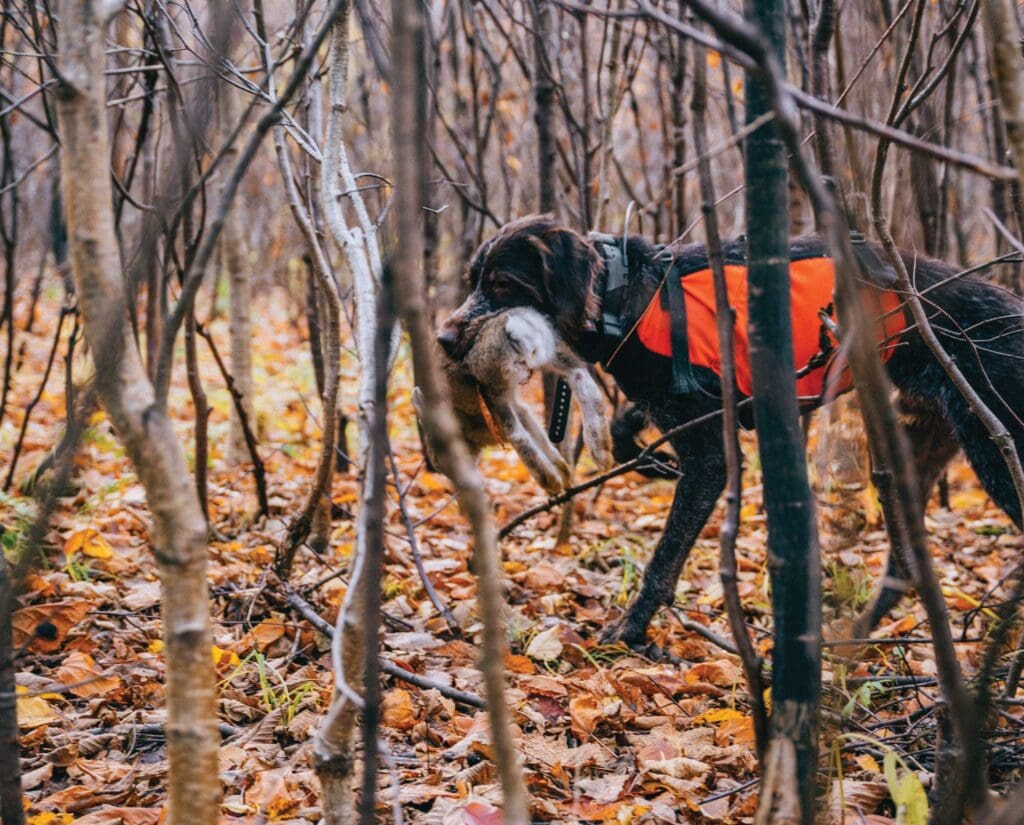
Wirehaired Pointing Griffon Retrieving Abilities
One of the prime goals of Eduard Korthals was to breed dogs possessing a strong desire to retrieve on land and in the water. Ever since, Griffon breeders have placed a natural retrieving instinct high on their list of priorities. As a result most Wirehaired Pointing Griffons today are excellent retrievers. Some may need more encouragement early on than others, but in general retrieving comes naturally to most.
Wirehaired Pointing Griffon Tracking Abilities
Griffons are said to be very good trackers. Test results from various organizations seem to support their assertions. Griffons bred and tested in Germany regularly pass the most demanding tracking tests. In North America, NAVHDA scores reveal that the breed does well in the Natural Ability test, a portion of which evaluates the tracking abilities of young dogs.
In France tracking, especially blood tracking of big game, is not typically viewed
as a job for pointing dogs. But tracking wounded birds or small game is, and in that regard the Wirehaired Pointing Griffon is said to be an excellent worker.
Wirehaired Pointing Griffon Water Work Abilities
There was a time, particularly in North America, when water work was not the strong suit of many Wirehaired Pointing Griffons. Fortunately, over the last 30 years tremendous progress has been made in that regard and many of today’s Wirehaired Pointing Griffons are excellent water dogs. Their harsh coat offers a good degree of protection and their calm, steady nature is an advantage in the duck blind.
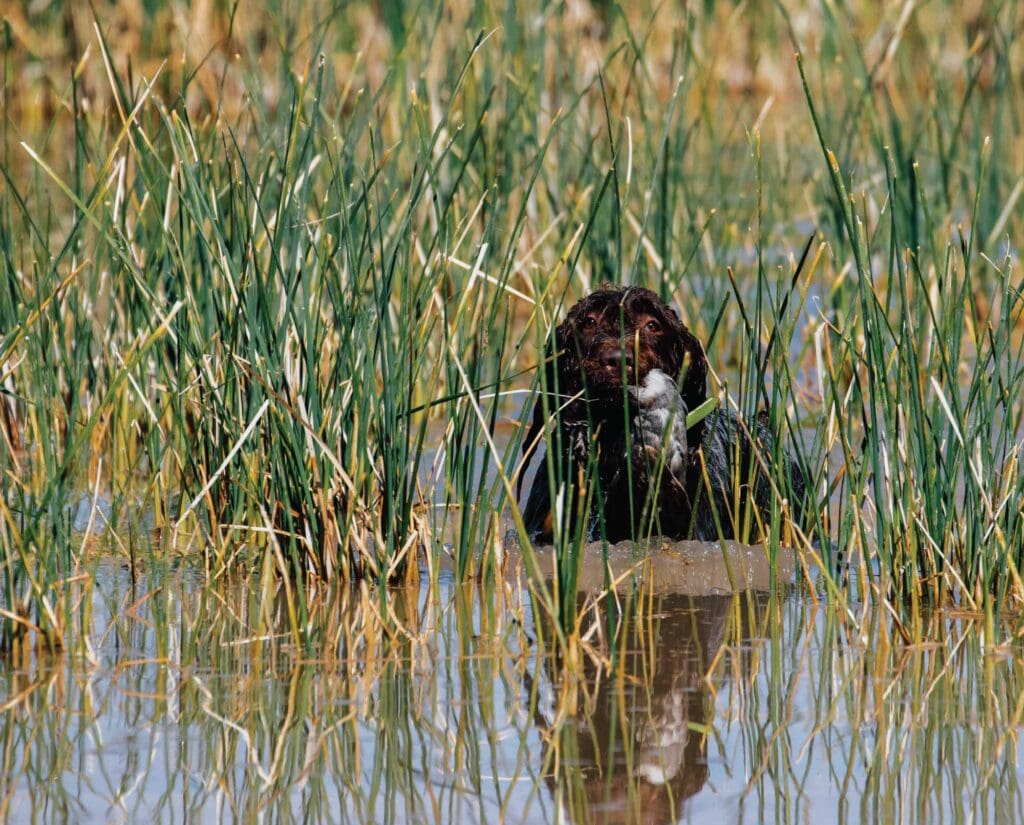
The Etymology of the Wirehaired Pointing Griffon
So, the wirehaired pointing griffon is the name of a pointing breed with a wire-haired coat that is part of the overall family of griffon-type dogs. Simple enough, right? Not quite. We need to keep in mind that the term “wirehaired pointing griffon” only came into widespread use after the turn of the 20th century. Depending on the source, rough-haired dogs were called everything from Polish and Hungarian water dogs, to pudels, budels and Hessian rough-beards. In fact when the first wirehaired pointing griffon was imported into the U.S. it was listed as a “Russian Setter.”
Even Eduard Karel Korthals, the founder of the breed, did not use the name griffon until the 1880s. He originally called his dogs smousbarts and when he moved to Germany he used the German term Drahthaarige Vorstehhunde, which means wire-haired pointing dogs. Eventually, he and members of the newly formed international breed club settled on the term “griffon.”
Elsewhere in Europe, other breeds of pointing dogs were developed from the same griffon-type ancestors. The Spinone Italiano, Cesky Fousek, Slovak pointer, wirehaired vizsla, Stichelhaar, German wirehaired pointer and Pudelpointer are all “griffons” in the broadest sense of the word. And since they all point and have wire-haired coats, are “wire-haired pointing griffons.”
“It was therefore logical, and even necessary, to put an end to the confusion that resulted from the fact that all griffons with a wire coat of various kinds had the same name expressed in different ways in French or German. By adding the word “Korthals” to the name of the breed, French griffon supporters proclaimed themselves the heirs and upholders of the works of the great breeder.” – Jean Castaing, Les Chiens d’Arret
So, today in France and Québec, breeders and owners call the breed Griffon Korthals. In conversation they shorten it to just “Korthals.” But the situation in other countries is not as cut-and-dry. The FCI website shows that the international organization can’t quite figure out where to put the word “Korthals” in the English translation of the name. On the website’s nomenclature page, Korthals is in the middle of the name: French Wire-Haired Korthals Pointing Griffon. But in the English translation of the standard published by the Fédération cynologique internationale (FCI), Korthals is at the end: wirehaired pointing griffon Korthals.
Americans solve the problem by simply dropping the word Korthals from the name. They refer to the breed as the wirehaired pointing griffon, and shorten it to “griff” in conversation.
In the U.K., it is the word “wirehaired” that is dropped. British breeders and owners call their dogs Korthals griffons. And in the German standard, the word griffon is dropped! The name on the German translation of the FCI standard is Französischer Rauhhaariger Korthals Vorstehhund (French rough-haired Korthals pointing dog)—yet the name of the German club representing the breed is Griffon-Club. Go figure!
An In-depth History of the Wirehaired Pointing Griffon
One of the most interesting – and frustrating – challenges I faced when writing my book Pointing Dogs Volume One: The Continentals was trying to come up with a reasonably accurate profile of the wirehaired pointing griffon. Despite the fact that the sporting literature from the late 19th century contains a wealth of information on the breed and that a good number of books have been written about it since then, I had a hard time coming up with a coherent summary of the breed’s development and its current situation.
What I discovered was that the wirehaired pointing griffon was created mainly in Germany by a Dutchman working under the patronage of an Anglophile German prince. Today, there is still a remnant population in Germany and even a small club for the breed there. But France has the largest population of griffons and the largest and most influential griffon club. It is also considered by the Fédération cynologique internationale (FCI) to be the parent country of the breed. The first griffon to make its way to North America was imported in 1887 and listed as “Russian Setter” by the AKC. More were brought over after the turn of the century and the breed eventually attracted a small but devoted following among North American hunters, particularly in Québec and the American Midwest.
Today, it is not difficult to find a well-bred, hard-hunting griffon in Europe or North America – if you do your homework. But, as I found out when I wrote the chapter on the breed, any homework on the griffon involves familiarizing yourself with the various types within the breed, the myriad of clubs representing it, and the sometimes quite different breeding directions followed by individual breeders.
So no wonder it took me such a long time to write the griffon chapter! Not only did I have to translate references from German, French, Dutch and English sources but I had to cut through the spin each one put on their version of the events that lead to the creation of the breed and how it should look and perform today. Heck, even the name of the breed took me an entire page to explain!:
Eduard Karel Korthals: Founder of the Wirehaired Pointing Griffon
Few specifics are known about the early development of many of the continental pointing breeds. But when it comes to the wirehaired pointing griffon a surprising amount of information is available about the breed and its creator, a young Dutch sportsman named Eduard Karel Korthals.
References to griffin-like dogs can be found as far back as the mid-16th century, but development of the wirehaired pointing griffon began in the Netherlands in the 1870s when Korthals set his sights on creating an all-purpose breed of gundog. The son of a wealthy Dutchman, Korthals developed a strong interest in the art and science of breeding livestock while growing up near Haarlem in the Netherlands.
In 1873 at age 22, he left his homeland to further his breeding projects at the estate of a wealthy patron named Prince Albrecht of Solms-Braunfels in Germany. By 1881 he was working full-time on the breed that would eventually take his name.
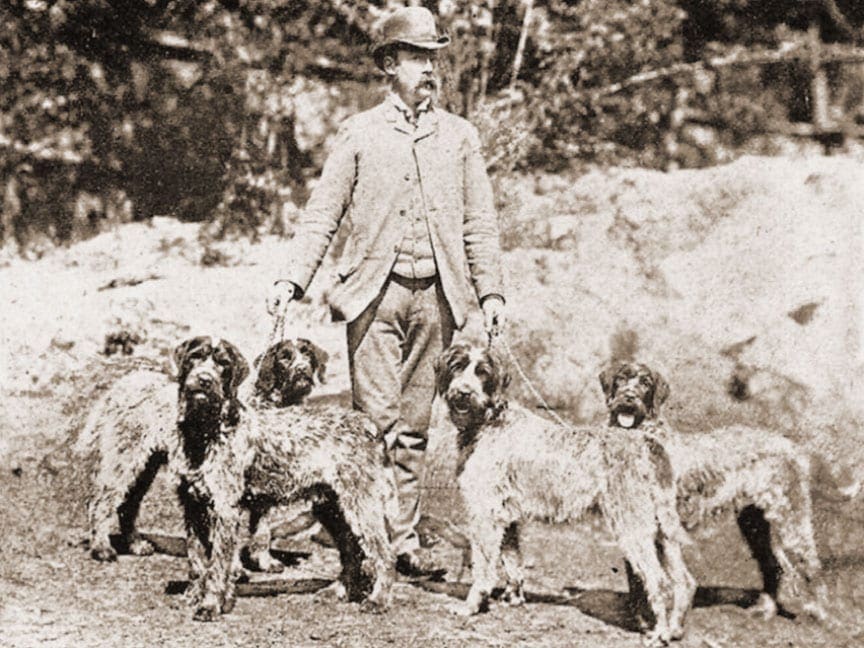
Korthals dreamed of creating a gundog that possessed the best qualities of English setters and English pointers, a keen desire for retrieving on land and in water, as well as an excellent ability to track wounded game. He was not alone in this desire; others had similar goals and were also attempting to create their own versions of a rough-haired, all- around hunting dog.
Pudelpointer breeders used pudels and pointers. It is not clear exactly what Stichelhaar breeders were using, but Korthals seems to have used just about anything he could get his hands on. His handwritten kennel book shows that between 1863 and 1876 he purchased 20 dogs including griffons, spaniels, a retriever, a three-quarter English pointer, a German spaniel, a Barbet, a Braque Français, a German shorthaired pointer, and two pointer-German-shorthair mixes.
Eventually, by judicious crosses of those dogs and many others, he developed his own strain of wire-haired pointing dog that would eventually make him famous around the world. But success did not come easily. Korthals was a Dutchman living in Germany, developing an international breed of gun dog with a French sounding name. And all this was at a time when political tensions were still running high after the Franco-Prussian war of 1870-71. So there were plenty of naysayers around ready to dismiss his dogs as mongrels, mutts or worse. One German writer wrote that:
“We will leave the griffons and the water spaniels unnoticed, otherwise we would have to pay attention to the pig as well, because that animal is also trained for hunting poultry.”
Eventually, two sides formed within the rough-haired dog breeding community. On one side, nationalistic supporters of the German breeds believed that their dogs were the only true rough-haired pointing dogs and that Korthals’ griffons were nothing more than impure “mutts.” On the other side were internationalists who believed that all the rough-haired breeds, pudelpointers, Stichelhaars, griffons and Spinoni were in fact one family, with various strains reflecting the personal preferences of their breeders. For a while, the international “one-big-family” opinion held sway. But when some breeders began to cross their rough-haired dogs to German shorthaired pointers, unity was lost and the breeds were declared separate and independent.
In 1888 a club was formed for the wirehaired pointing griffon. It was international in scope with German, French, Dutch and Belgian members. A stud book was created with records kept in German, French and Dutch. With its publication in 1888, the wirehaired pointing griffon became the first breed to have an official stud book and the first to be represented by an international club.
Throughout the 1880s and into the 1890s, Korthals continued to develop his breed and was instrumental in establishing the first formal testing system for versatile hunting dogs. His dogs proved to be outstanding performers in these tests and soon gained an enthusiastic following in Germany, France, Belgium and the Netherlands. Tragically, just as he was winning the highest praises of the sporting dog press, Korthals developed cancer of the larynx. He died of the disease on July 4, 1896. He was only 44.
The Wirehaired Pointing Griffon moves to France
In the years following Korthals’ death, a group of followers continued to breed dogs according to the standard established in 1897. Independent breed clubs were formed in Belgium and in France, but the stud book for the breed remained in Germany until the First World War. After the war, separate stud books were established in France and Belgium, while in Germany the wirehaired pointing griffon joined the pudelpointer and the Stichelhaar in a club representing all three breeds.
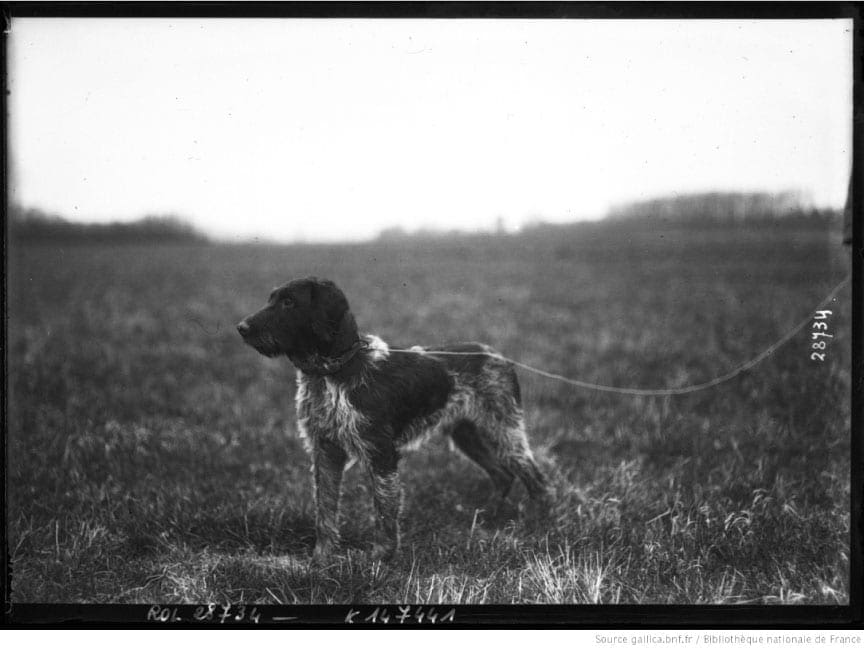
World War Two had severely reduced the Griffon population in Europe, especially in Germany. But by the end of the 1950s there were signs of a comeback, most notably in France where the wirehaired pointing griffon was well on its way to becoming one of the most popular gun dog breeds among French hunters. German, Belgian, Dutch and American breeders continued to breed wirehaired pointing griffons as well, but in very limited numbers. In 1951 the French club added the word “Korthals” to the official name and declared itself the breed’s parent club.
Today the wirehaired pointing griffon remains much as it was when Korthals first developed it: a robust, all-around bird dog, well adapted to hunting in the field, forest and water. The breed enjoys a loyal following among hunters throughout much of Europe and North America. In terms of numbers, France is home to the largest population. French breeders annually produce over 2000 wirehaired pointing griffons and their club, Club Français du Griffon d’Arrêt à Poil Dur Korthals, is by far the largest of the half-dozen wirehaired pointing griffon clubs in the world.
Elsewhere in Europe, the breed faces stiff competition from the other wire-haired breeds. In Germany, for example, there are fewer than 100 wirehaired pointing griffons whelped each year compared to over 3,000 German wirehaired pointers. In the United States and Canada the breed has a small but devoted following, with approximately 350 wirehaired pointing griffon pups whelped in those countries each year.
Eduard Korthals developed the wirehaired pointing griffon by systematically crossing a variety of breeds and types to create his own strain of all-around gun dog. Once his breed was established and its standard set, his followers sought to adhere as closely as possible to the founder’s original vision. For the most part they succeeded. I am sure that if Korthals were here today, he would easily recognize many of the modern dogs that carry his name. But I am equally certain that he would be surprised to see how many different types can now be found within the breed.
In order to find out how the breed ended up with such a variety, we need to follow the twists and turns in the wirehaired pointing griffon’s development after the death of Korthals in the three main areas where breeders continued to develop it: Germany, France and North America.
Wirehaired Pointing Griffons in Germany
The vast majority of Korthals’ work was done in Germany while he was under the patronage of Prince Albrecht of Solms-Braunfels, one the most influential personalities on the German gun dog scene of the time. Yet Korthals’ dogs never really achieved the level of acceptance among German hunters that he had hoped for. It is now clear that they fell victim to two powerful forces: competition and nationalism.
As Korthals was working on his breed, there were other gundog breeds under development in Germany which were promoted as being more “Germanic” than the wirehaired pointing griffon with its French sounding name and international background. Korthals was also accused of using “foreign blood,” something he always denied. In 1888 he wrote, “From the beginning up to today, i.e. 18 years, I have bred only with griffons without the aid of a foreign breed.”
After the death of its creator, and in the years leading up to the First World War, the wirehaired pointing griffon became increasingly marginalized in Germany. Many of its supporters joined the German wirehaired pointer movement, taking some of their best dogs with them. By the 1930s there were practically no wirehaired pointing griffons left in Germany.
Surprisingly, after the Second World War the original breed club was re-formed in West Germany where a few diehard breeders had managed to keep their lines alive. In East Germany the breed was completely absorbed into German wirehaired pointer lines. Today in reunified Germany wirehaired pointing griffon breeders produce approximately 80 pups per year.
Wirehaired Pointing Griffons in France
In France, after the death of Korthals, the people who continued his work tried to follow his vision and did their best to keep their lines “pure”—at least at first. In the 1920s, perhaps motivated by the increasing competition from English pointers and setters, some breeders attempted to “regenerate” their lines by crossing to the English breeds. Former president of the Club Français du Griffon d’Arrêt à Poil Dur Korthals in France, Jacques Carpentier, wrote about this period in his book Le Griffon d’Arrêt de Korthals, published in 1998. He claims that in 1925, as breeders became increasingly worried about the state of the breed and especially concerned about its inability to compete with other breeds in trials, French dog expert Ronan de Kermadec “set fire to the powder by advocating a cross to the pointer”.
Apparently a number of prominent club members agreed with de Kermadec’s suggestions and crossed pointers and setters into some lines. Carpentier mentions that a certain Colonel Dommanget was involved in the case of a “dark pseudo-griffon, named Homer” from pointer lines that was exported to the U.S. and used there for breeding. But “the results of the offspring were terrible, and at the time undoubtedly brought a hard knock to American griffons.”
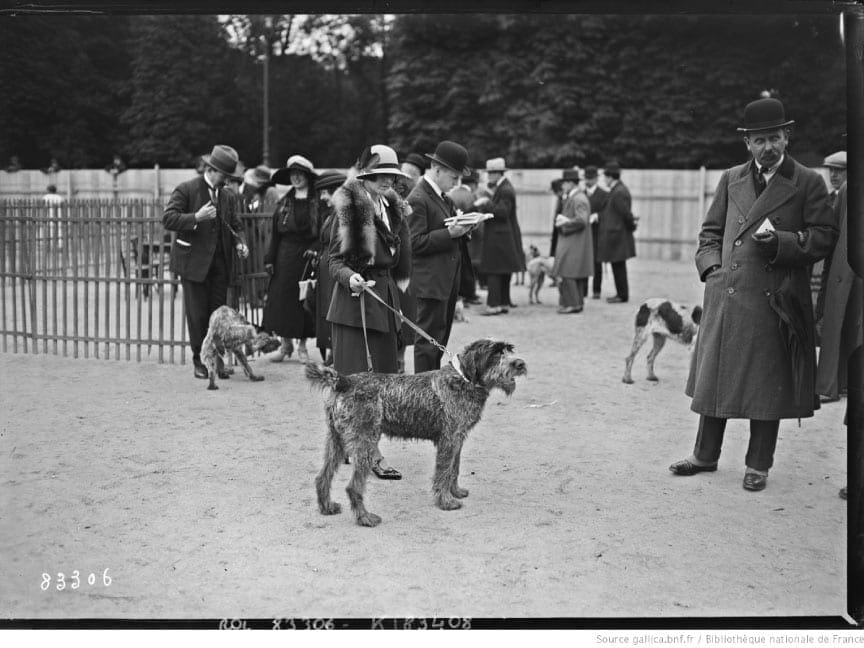
It is not clear just how much crossbreeding actually occurred in France in the 1920s and ’30s. In all likelihood there was some, but with the onset of the Second World War dog breeding of any kind came to a near standstill.
Interest in the breed was rekindled after the war. The Griffon population in France continued to expand throughout the 1950s and ’60s, and by the 1970s it was one of the most popular gundogs in the country. In the late 1990s rumblings about “unorthodox” breeding practices were heard once again. Soon complaints were being circulated via private letter and e-mail. Eventually, they were voiced at club meetings. In 2008 the debate spilled into the open.
A group called the “Circle for the Defense of the Korthals Griffon” was formed and its members leveled shocking accusations at some of the country’s most high-profile breeders. Led by Jacques Carpentier, the group claims that increasing numbers of wirehaired pointing griffons are being bred well outside of the breed standard in terms of performance and appearance. They contend it is due mainly to wholesale crosses, mainly to English setters, in some of the most prominent griffon lines in the country.
Beyond just sounding an alarm, the Circle’s main goal is said to be the promotion and defense of what it calls “authentic” Korthals griffons. They contend that griffons from “clean” lines still correspond very closely to Korthals’ original vision in terms of performance and overall appearance. The supposedly crossbred dogs, on the other hand, are said to have a different look. Some have very light or long coats and some even have tan points above the eyes. Some are said to also have a different hunting style, running almost as fast and far as English setters and English pointers.
On the other side of the debate members of the Club Français du Griffon d’Arrêt à Poil Dur Korthals, including the current board of directors, vehemently deny the accusations. They refuse to accept that there has been any deliberate crossbreeding and claim that the increase in speed and range seen in some of the wirehaired pointing griffon’s lines has come only from selective breeding. They contend that the oddly colored coats are simply throwbacks to the founding breeds used by Korthals and others, and even now are bound to occur from time to time.
Whatever the truth of the matter—my guess is that it is probably somewhere in the middle—the fact remains that the French produce many of the best wirehaired pointing griffons in the world today.
Wirehaired Pointing Griffons in North America and Beyond
The first wirehaired pointing griffons arrived in North America in 1887, and despite being far away from the German and French influences they became the subject of much controversy in America. Between 1983 and 1986 the breed went through some fundamental breeding shifts that involved the introduction of “foreign” blood and resulted in the splitting of its North American club.
The Wirehaired Pointing Griffon Club of America (WPGCA) formally split into the American Wirehaired Pointing Griffon Association (AWPGA) which is now the breed’s parent club in the AKC. The results of the “foreign” blood experiment was the introduction of the Cesky Fousek (Bohemian wirehaired pointing griffon), a breed from the Czech Republic. Eventually the originally club was renamed the Cesky Fousek North America. Both are respectable organizations and breeds.
READ: The Wirehaired Pointing Griffon Controversy in North America
But beyond the dogs themselves, my research into the history and development of the wirehaired pointing griffon has opened my eyes to the fact that dog breeds are really just the physical manifestation of the ideologies, hopes and dreams of the people who breed them. Today, for better or worse, the Griffon is in the hands of several different groups each of which is following a slightly different path. The fact that good, solid gundogs can still be found within most of those groups is testament to the vitality of the breed and the vision of its founder, Eduard Korthals.
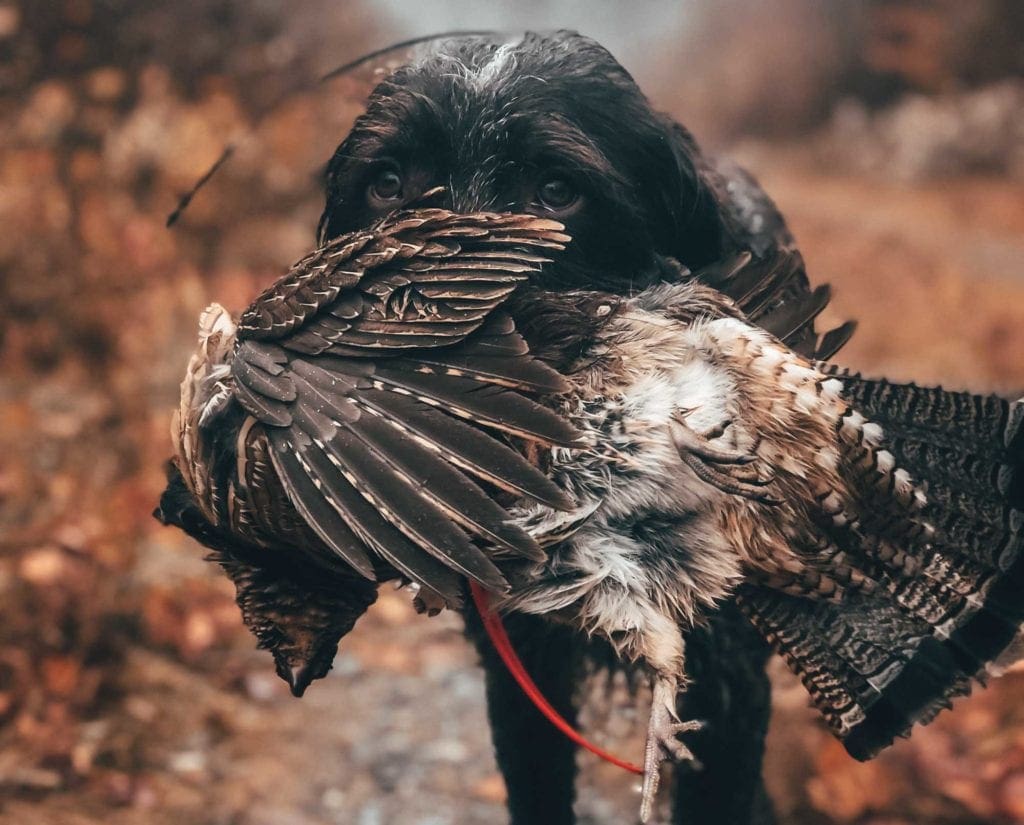
Hunting Dog Confidential Editor Craig Koshyk’s take on the wirehaired pointing griffon
I have had the pleasure of watching a good number of Wirehaired Pointing Griffons work in the field, forest and water in North America and in Europe. I’ve hunted over a few right here in my home province of Manitoba and watched Griffons run in NAVHDA tests in the pothole country of North Dakota and in the rolling hills of central Québec. I’ve seen a fair number run in field trials in the sprawling wheat fields of northern France, and I have even watched a young Griffon hunt in a polder (a small field enclosed by dikes) near the Dutch city of Haarlem—where Eduard Korthals himself was raised.
Each time I saw one I came away with an even greater appreciation for the breed. The best Wirehaired Pointing Griffons I have seen left me no doubt regarding their purpose in life: they hunt. And while they may not be quite as hard-charging as some breeds, nor as fast or far-ranging as others, the good ones are outstanding all-around workers with a great personality and classic rough-haired look.
But beyond the dogs themselves, my research into the history and development of the Wirehaired Pointing Griffon has opened my eyes to the fact that dog breeds are really just the physical manifestation of the ideologies, hopes and dreams of the people who breed them. Today, for better or worse, the Griffon is in the hands of several different groups each of which is following a slightly different path. The fact that good, solid gundogs can still be found within most of those groups is testament to the vitality of the breed and the vision of its founder, Eduard Korthals.
From their home base in Winnipeg, Craig Koshyk and Lisa Trottier travel all over hunting everything from snipe, woodcock to grouse, geese and pheasants. In the 1990s they began a quest to research, photograph, and hunt over all of the pointing breeds from continental Europe and published Pointing Dogs, Volume One: The Continentals. The follow-up to the first volume, Pointing Dogs, Volume Two, the British and Irish Breeds, is slated for release in 2020.





Thanks for a great article. I hunt over a female WPG and she is an amazing hunting dog and companion.
I was always told that the WPG along with Stichelhaars, GSPs, and Pudelpointers is one of 4 Foundation breeds for the GWP/Drathaar . Funny, that wasn’t included in this analysis.
“Elsewhere in Europe, other breeds of pointing dogs were developed from the same griffon-type ancestors. The Spinone Italiano, Cesky Fousek, Slovak pointer, wirehaired vizsla, Stichelhaar, German wirehaired pointer and Pudelpointer are all ‘griffons’ in the broadest sense of the word. And since they all point and have wire-haired coats, are ‘wire-haired pointing griffons.'”
Yes, Korthal’s Griffon (WPG) is one of the four foundation breeds of the Drahthaar. But the pioneering breeders of Drahthaars mainly used Stichelhaars and Pudelpointers in their programs. Griffons were used, but much less frequently. Crosses to German Shorthaired Pointers were undertaken later on.
Great article. After hunting with labs for over 35 years I researched and switched to a Griff. He has been my best hunting partner. I really appreciated “The roading style is always feline and done with determination and drive. The dog crouches more and more as he approaches the game. He can end up with his belly on the ground when he finally stops…” When Crockett does this I know the bird is near. He by far is the best all around hunter I have ever hunted with.
Terrific article! I’m sitting here with my 8 week old WPG and a GSP. The GSP is a terrific breed but to me it seems over the top with energy. So far I’ve noticed a significant difference in a short time in the amount of energy between the two. Another thing I noticed right of the bat is this pup tends to go to its belly when stalking something. I found that odd and was worried something was wrong but it seems it’s just in her heritage. Super interesting article! Thank you for all the research.
In the 90’s I researched hunting breeds to replace my Labrador. I chose the WPG and in 2011 got a pup. Using a stack of reference books both of us learned how to train each other and it ended up being a great experience for both. He flushes grouse, points woodcocks steadily and retrieves everything I kill including hare and ducks. His hunting drive is amazing, his willingness to plow through anything remains astonishing. He’s a great house dog and companion. Cautious with strangers but never sharp. I was surprised to find out most of the quirks they say about the breed are true. They get bored easily during training sessions and the only game he’ll do all day is find the dummies I hide from him in the yard. Unlike a labrador, he will only retrieve 6-7 doubles and then I have to switch to something else. He never steals any food no matter what it is or how easily he can reach it unless it reaches the floor and then will probably wait for my OK. He was never a close worker which is a problem in our thick Atlantic Canada woods. To this day he finishes all his training sessions by racing around me in figure 8’s or circling things in the yard and zooming close to me. He’ll even do it when we take a break for lunch while hunting. An amazing dog.
Fantastic article, I have my 3 1/2 year-old with me right now, and she is the love of our life! One thing left out of the article is that these dogs are incredibly intelligent. They are the smartest dogs out there at least that I have seen. They hunt hard as heck and all the other points about them hunting like cats is definitely true. If you’re looking for a pup to go bird dog hunting with you can’t beat this breed. Great job on the article. congratulations.
I really enjoyed reading more about this fascinating breed. I’m considering getting a dog next year and I am trying to do lots of research so as to pick the right dog for myself and my wife. I am retired and live in a semi-rural area. I’m 63 but fairly active for my age, and would like a dog that is a great family member and also enjoys hunting or hiking in the woods and fields. Would the wire-haired pointing griffon be a good choice? Thanks for any advice you can give.
I want one but I do have a Lab at the moment …. My cousin hunts with Griffons for pheasants in Montana but mostly North Dakota 👍
Great article, as usual. So, what is “the slowest, most deliberate pointing breed available.” I hear phrases like this thrown around but usually in the context of being rejected, as it was here. Is there a consensus for such a breed?